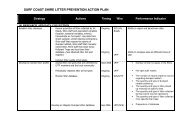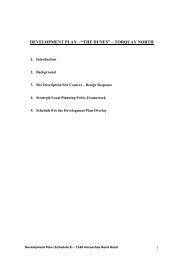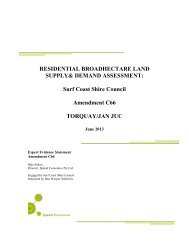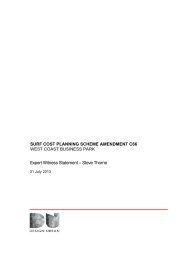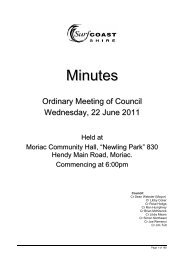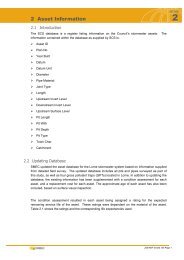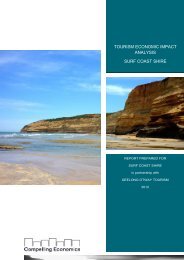Rural Strategy - Surf Coast Shire
Rural Strategy - Surf Coast Shire
Rural Strategy - Surf Coast Shire
You also want an ePaper? Increase the reach of your titles
YUMPU automatically turns print PDFs into web optimized ePapers that Google loves.
<strong>Surf</strong> <strong>Coast</strong> <strong>Shire</strong> <strong>Rural</strong> <strong>Strategy</strong> Review<br />
Final Report<br />
development between towns, development at township and natural landscape edges and<br />
along road corridors were identified as critical to maintaining landscape character and<br />
values. Reducing the minimum lot size particularly at urban boundaries for rural residential<br />
development would have significant negative impacts on landscape character.<br />
It is a recommendation of this study that the basis for establishing minimum lot sizes be<br />
broadened from a consideration of land units to support agriculture to include consideration<br />
and protection of the rural-farmed landscape.<br />
9.10 Dwellings<br />
In seeking to minimise the fragmentation of rural land, there is a need to achieve a cultural<br />
change in the expectation that a dwelling may be constructed on every lot. The primary<br />
justifications for a house on a rural lot must be that it complements and improves the<br />
agricultural use of the land and preserves the existing rural character of the area.<br />
In the Farming Zone a permit is not required to use land for a dwelling provided it meets the<br />
minimum lot size specified in the zone schedule. On smaller lots a permit may be granted,<br />
provided (amongst other things) that the dwelling is reasonably required for the operation of<br />
the rural activity conducted on the land.<br />
This provision allows for a wide interpretation of what is “reasonably” required for a rural<br />
activity and, indeed, what is considered to be a bone fide rural activity. Without clear<br />
guidelines it will be very difficult to make effective and consistent decisions, particularly if an<br />
applicant uses personal hardship or family reasons to reinforce the planning grounds.<br />
Given that the purpose of the provision is to limit the proliferation of dwellings in a rural zone,<br />
it would create a dilemma if Council were to approve a dwelling on an existing single small<br />
lot, but refuse a dwelling on a similar sized lot which was part of a multiple land holding. In<br />
the first instance, there has been an historical expectation that a person can build a dwelling<br />
on a lot if it exists as a single tenement holding before the introduction of planning scheme<br />
controls. In the second case, if permits were to be issued for dwellings on all existing<br />
undersized allotments throughout the <strong>Shire</strong> this would result in substantial fragmentation and<br />
loss of existing rural land.<br />
Council has addressed this problem through the use of tenement provisions at Clause 22.02<br />
(<strong>Rural</strong> and Environmental Development Policy). That is, a dwelling will only be permitted on<br />
a lot less than the minimum size for the zone provided that the lot has historically been in<br />
different ownership to adjoining lots.<br />
In the past, tenement provisions have been generally effective in limiting the number of<br />
houses built in the rural area and in encouraging retention of rural land holdings and their<br />
continued use for traditional farming production. By maintaining this policy, an equitable<br />
entitlement to housing is managed which avoids the encouragement to fragment land<br />
holdings. Owners can build on smaller existing tenements without prejudicing the decision<br />
guideline requiring, in all other cases, that an application for a house on an undersized<br />
allotment be justified on the basis of being required for the operation of the rural activity.<br />
RMCG Consultants for Business, Communities & Environment Page 55



